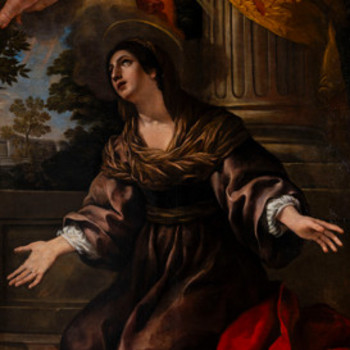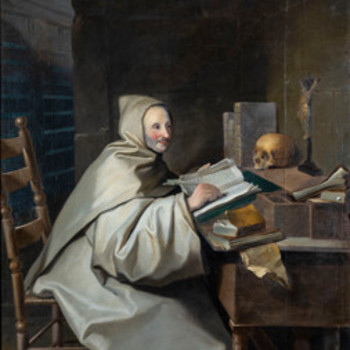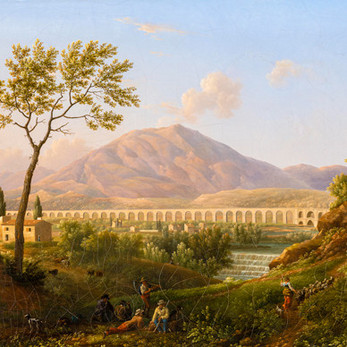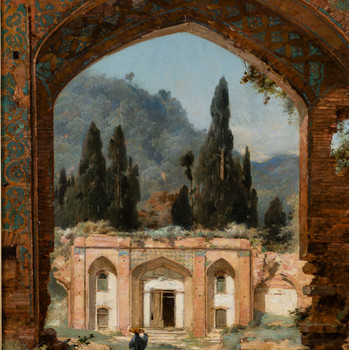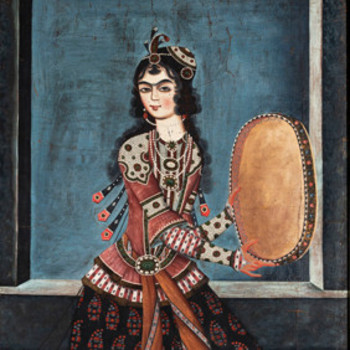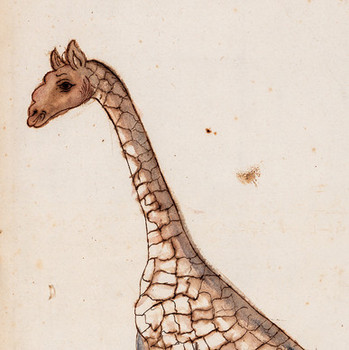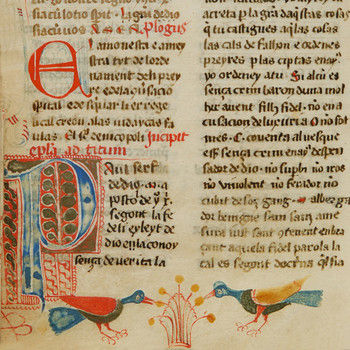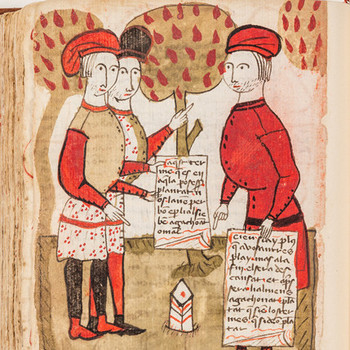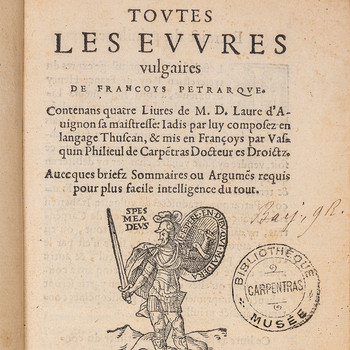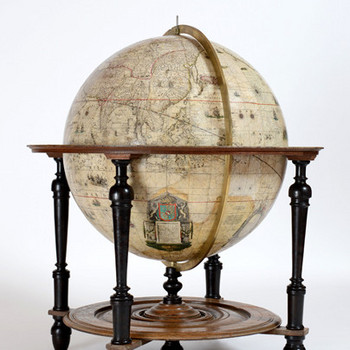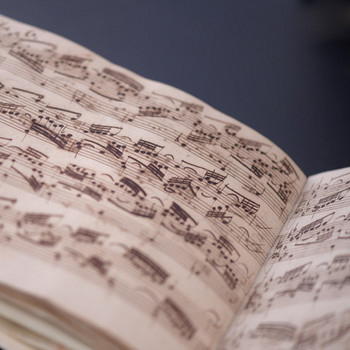Remarkable Works of Art
The Inguimbertine library museum is simply bursting with historical treasures. Below is a selection of some of the remarkable works of art that you will be able to admire during your visit.
Funerary stele in honour of Taba
Carved and engraved limestone, Memphis (Egypt), between the 5th and 3rd century BCE.
Inv. no. 2007.0.16 - Dimensions: H: 50 cm; W: 33 cm
Discovered in Memphis, Egypt, in 1704, this stele, first purchased by the Marseille native Jean-Pierre Rigord, was sold back and forth through various learned people across Provence before ending up in Carpentras in 1744, when Dom Malachie d’Inguimbert acquired the collection from the Mazaugues family in Aix-en-Provence. Since its discovery, the antiquarian community had debated over whether the inscription used the Phoenician alphabet or the demotic Egyptian script that might hold the key to deciphering hieroglyphics. Bernard de Montfaucon published it in his book, Antiquité expliquée et représentée en figures (‘The Antiquity Explained and Shown Through Figures’, in fifteen volumes published from 1719 to 1724), and presented it as being the way that Ancient Egyptians actually wrote, i.e., without hieroglyphics. Thanks to a cast mould that faithfully reproduced the original, Jean-Jacques Barthélémy, an antiquarian specialising in eastern languages, put an end to the debate in 1762 by demonstrating that the inscription was actually Aramaic (written in the Phoenician alphabet), which he translated into French. This was subsequently translated into English by Charles Cutler Torrey as follows:
« Blessed is Taba, daughter of Tahapi, devotee of the god Osiris; She, who to none did aught of evil, by whom no slander whatever was spoken. Before Osiris be thou blest, before him take the gift of water; Be thou (his) worshipper, my fair one, and among his saints be thou complete.»
This stele is the oldest piece of writing preserved at the Inguimbertine.
Workshop of Pietro da Cortona (Cortona, 1596 – Rome, 1669), Santa Dafrosa
Oil on canvas, 1640.
Inv. no. 2012.2.1 - Acquired with the help of the ‘FRAM’ Regional Museum Acquisition Fund - Dimensions: H: 187 cm; W: 119 cm
In 1657, Cardinal Bichi left Cardinal Mazarin a painting by Pietro da Cortona, which he kept in his Episcopal Palace in Carpentras. The three people in this sentence were all major figures in 17th century Europe: Alessandro Bichi (1596-1657) was a distinguished diplomat and art aficionado who enjoyed the support of Pope Urban VIII and King of France Louis XIII, as well as being a close friend of the influential Cardinals Richelieu and Mazarin; Pietro da Cortona (1597-1669) was one of the most famous artists on the European Baroque scene; Cardinal Mazarin was a powerful man and godfather to Louis XIV.
In 1624, in celebration of the rediscovery of the tomb of Saint Dafrosa, a 4th century Roman martyr, Pope Urban VIII commissioned an altarpiece from Pietro da Cortona for the Santa Bibiana church in Rome. In 1640, the Pope asked the painter to make two copies, one of which was given to Alessandro Bichi, then Bishop of Carpentras.
This painting is a beautiful example of Baroque imagery: its composition is centred on Saint Dafrosa, who is acting as a bridge between the earthly and heavenly worlds; her stance and expression are designed to create an emotional response; the surrounding objects are charged with symbolic meaning; in short, everything harks back to the post-reform purpose of Catholic imagery, which was to please, to teach, to move.
Workshop of Hyacinthe Rigaud (Perpignan, 1659 – Paris, 1743), The Abbot of Rancé (Paris, 1626 – Soligny-la-Trappe, 1700)
Oil on canvas, early 18th century.
Inv. no. 887.2.1 - Dimensions: H: 237 cm; W: 193 cm
This painting was a gift from Pope Clement XII to d’Inguimbert when he left Rome for Carpentras in 1735. It depicts the Abbot of Rancé, a famous reformer of the Abbey of La Trappe, where d’Inguimbert, himself a Trappist monk, wrote his biography which he published in Italian and Latin. This portrait was commissioned by the Marquis de Saint-Simon and painted by Hyacinthe Rigaud in 1699 without the Abbot of Rancé’s knowledge; Rigaud worked on the painting during interviews the abbot gave to the marquis which he attended in disguise. Rigaud subsequently created copies, including the one which was given to Pope Clement XII.
Nicolas Dipre (working in Avignon from 1495 to 1532), Meeting at the Golden Gate
Oil on wood, between 1499 and 1501.
Inv. no. 1757.1.121 - Dimensions: H: 70.5 cm; W: 75,5 cm
This panel is the last vestige of an altarpiece commissioned from Avignon-native Nicolas Dipre by the Confraternity of the Immaculate Conception in 1499 to decorate its chapel in the Saint-Siffrein cathedral of Carpentras. According to legend, this kiss shared been Anne and Joachim at the Golden Gate of Jerusalem is what resulted in the in the birth of the Virgin Mary. Despite an undeniable Italian influence, this painting boasts a Gothic style which had been out of fashion since the Renaissance. And yet, in the mid-18th century, at a time when classical tastes abounded, d’Inguimbert demonstrated an ahead-of-the-curve interest in this art style when he displayed this piece in his library.
Joseph-Siffred Duplessis (Carpentras, 1725 – Versailles, 1802), Self-portrait
Oil on canvas, 1780.
Inv. no. 2009.0.4 - Dimensions: H: 71 cm; W: 61 cm
Duplessis painted this self-portrait when he was at the height of his career. He depicted himself smiling, with rosy cheeks and sparkling eyes, wearing a lustrous silk jacket, demonstrating both his technical skill and his talent at creating a psychologically faithful portrait.
Jean-Joseph Xavier Bidauld (Carpentras, 1758 – Montmorency, 1846), View over the Carpentras Aqueduct
Oil on canvas, around 1808-1810.
Inv. no. 367 bis - Dimensions: H: 76 cm; W: 96 cm
This piece is an illustration of Bidauld’s work at creating idealised, unrealistic landscapes. The aqueduct forms a horizontal line splitting the painting into two sections. The lower half, dominated by green hues, depicts a leafy, busy foreground, in contrast to the upper half bearing a blue sky and large mountain in brown hues. These representations of the Ventoux mountain, the aqueduct and the falls of the Auzon river do not correspond to reality, and were instead redesigned to balance the composition.
Jules Laurens (Carpentras, 1825 – Saint-Didier, 1901), Ruins of Ashraf Palace in Persia
Oil on canvas, 1848 and 1894.
Inv. no. 320 - Dimensions: H: 87 cm; W: 76 cm
This painting was inspired by a drawing that Jules Laurens produced during his travels in Iran from 1845 to 1848. He brought hundreds of drawings back with him, which he used as inspiration to produce the paintings in his workshop which ultimately resulted in his reputation as an orientalist painter during the second half of the century. He regularly exhibited these paintings at the annual art exhibition, the Salon des artistes français.
Dancer with a Tambourine
Oil on canvas, Persia, around 1820.
Inv. no. 849.6.1 - Dimensions: H: 156.6 cm; W: 105 cm
After his travels in Iran, Jules Laurens brought back the pieces he created during the Qajar dynasty (reign: 1786 to 1925). His four large paintings likely came from a single series intended to decorate one of Fath-Ali Shah’s palaces (reign: 1797 to 1834). The images of sumptuously dressed warriors and dancers around the Shah’s portrait added to his prestige. 19th century Iranian art adopted Western techniques, such as oil on canvas painting, but remained true to the Eastern traditions of two-dimensional images. Figures are shown from the front with no attention paid to shape and depth, and they stand out from a backdrop where a sense of perspective is created using a column or window. Over large, single-colour backgrounds, the artist took care to meticulously paint a remarkably detailed and accurate face, clothes, and jewellery.
Nicolas-Claude Fabri de Peiresc (Belgentier, 1580 – Aix-en-Provence, 1637) An Observation of the diverse marvels of nature
French - Manuscript on paper, watercolour drawings. Soft parchment binding, 17th century.
Ms no. 1821 (d’Inguimbert collection) - Dimensions: H: 340 mm; W: 240 mm
Peiresc, a renowned polymath nicknamed the “Prince of the Curious” due to his insatiable thirst for knowledge, compiled many notes and documents on a broad range of subjects, which are now stored across 116 records at the Inguimbertine. This record combines drawings and missives on zoology, botany and anatomy.
Vaudois Bible
Vernacular Roman - Manuscript on parchment, illuminated. Goatskin binding, late 13th/early 14th century
Ms no. 8 - Dimensions: H: 180 mm; W: 130 mm
The Vaudois Bible is considered to be the first vernacular translation of the Bible, and only seven copies remain in existence today. It was used by itinerant preachers known as ‘barbes’ who, following Peter Waldo, were dedicated to sharing the Bible’s teachings in a language that all could understand.
A Treatise on Land Surveying
Provençal - Manuscript on paper, watercolour drawings, 15th century. Two volumes, modern calfskin binding
Ms no. 327 (d’Inguimbert collection) - Dimensions: H: 225 mm; W:180 mm
Written entirely by Bertrand Boysset, a gentleman of Arles (around 1345-1414) in 1405, this practical essay on geometry is divided into two sections: the art of land surveying, and the art of land marking. He also inserted information on geography and astronomy, including multiple depictions of the earth and cosmos illustrating the state of people’s knowledge of the world in the 15th century.
Francis Petrarch (Arezzo, 1304 – Arquà, 1374), All the vulgar works of Francis Petrarch translated into French by Vasquin Philieul de Carpentras
Avignon, Barthélémy Bonhomme, 1555.
French - Printed book. Binding by Lortic in garnet-coloured Moroccan leather, around 1860.
Imp Rés. no. A 86 (Barjavel collection) - Dimensions: H: 170 mm; W: 110 mm
Casimir Barjavel, a learned man from 19th century Vaucluse, took an interest to publishing houses in Avignon and the Comtat Venaissin and ultimately built up a collection of rare books which he bequeathed to the Carpentras library in 1868. This book from Avignon is an example of this interest, particularly given that the humanist Francis Petrarch had a significant impact on the region, as he spent time living in both Avignon and Carpentras and detailed his ascent of the Ventoux in 1336.
Willem Blaeu (1571-1638), Terrestrial globe, Amsterdam: 1622.
Wood and plaster frame, printed gores using copper plates etched using jets of water and a chisel, watercolour highlights; Globe mounted in a wooden cabinet.
Inv. no. CAR 1 - Dimensions: 68 cm in diameter
Willem Blaeu was a famous cartographer and publisher working in Amsterdam. He was behind several prestigious globes representing both the earth and the skies; these spherical objects had a wooden and plaster frame on which strips of printed paper (gores) representing the earth or sky were stuck, sometimes illuminated using colour. For this terrestrial globe produced in 1622, Blaeu’s company took great care to show accurate, up-to-date information. To this end, many inscriptions indicate the locations of recent major discoveries, such as the Cape of Good Hope passage discovered by Vasco da Gama, or the routes followed by Magellan and Francis Drake on their round-the-world voyages. In particular, this globe depicts some of the freshest striking discoveries of the time, such as the revolutionary voyage of Willem Schouten and Jacob le Maire, Dutch seafarers who opened up a new route to the Pacific by sailing around Cape Horn during their expedition in 1615-1616.
As well as seafaring routes, the terrestrial globe attests to people’s knowledge of the continents at the time. The precise records of Europe and Asia are revealed through the dense network of cities and landmarks shown in these regions. Conversely, the inland areas of Africa and the Americas had yet to be explored, as had the coastline of North America. Australia had not yet been discovered.
Johann Sebastian Bach, “Sei gegrüsset Jesu gütig”
German - Autograph manuscript on paper (14 pages)
Dimensions: H: 240 mm; W: 185 mm
The history of this autograph chorale with eleven variations was revealed through an annotation in German added above the title: “The composer wrote this chorale while the organist Kittel was still his student; it is he that gave me this as a souvenir. I in turn am giving it as a souvenir and sign of friendship to Mr Jean-Joseph Bonaventure Laurens. Signed: Rinck. Darmstadt, 30 September 1841.”
Esther scroll
Hebrew - Manuscript on parchment, painted, 15th century (?). Scroll rod in turned, sculpted, painted, gilded wood, 18th century
Ms no. 2627 (donation from Blanche Mossé, a descendent of a long-standing Jewish family in the Comtat Venaissin) - Dimensions: Depth: 250 mm
This illuminated manuscript of the Book of Esther was read during Purim (the Jewish Festival of Lots). Its painted decorations along the scroll’s edges and tips include leafy, floral scrollwork reminiscent of the illuminated manuscripts of the 15th century. The assembled sheets of parchment are rolled up around a wooden rod with a handle and bobeche at its tip, with sculpted geometric scroll shapes that are painted and gilded in an almost Rococo style, as was the fashion in the mid-18th century, in reference to the characteristic style of the Carpentras synagogue which was reconstructed in 1740 and again in 1770. This scroll, in a synagogue-ready format, was donated to the Inguimbertine by Blanche Mossé (1888-1965) in 1964. Blanche Mossé was the custodian of the synagogue and worked in the shadows during the Nazi occupation to hide the sanctuary’s furniture and objects of religious significance.
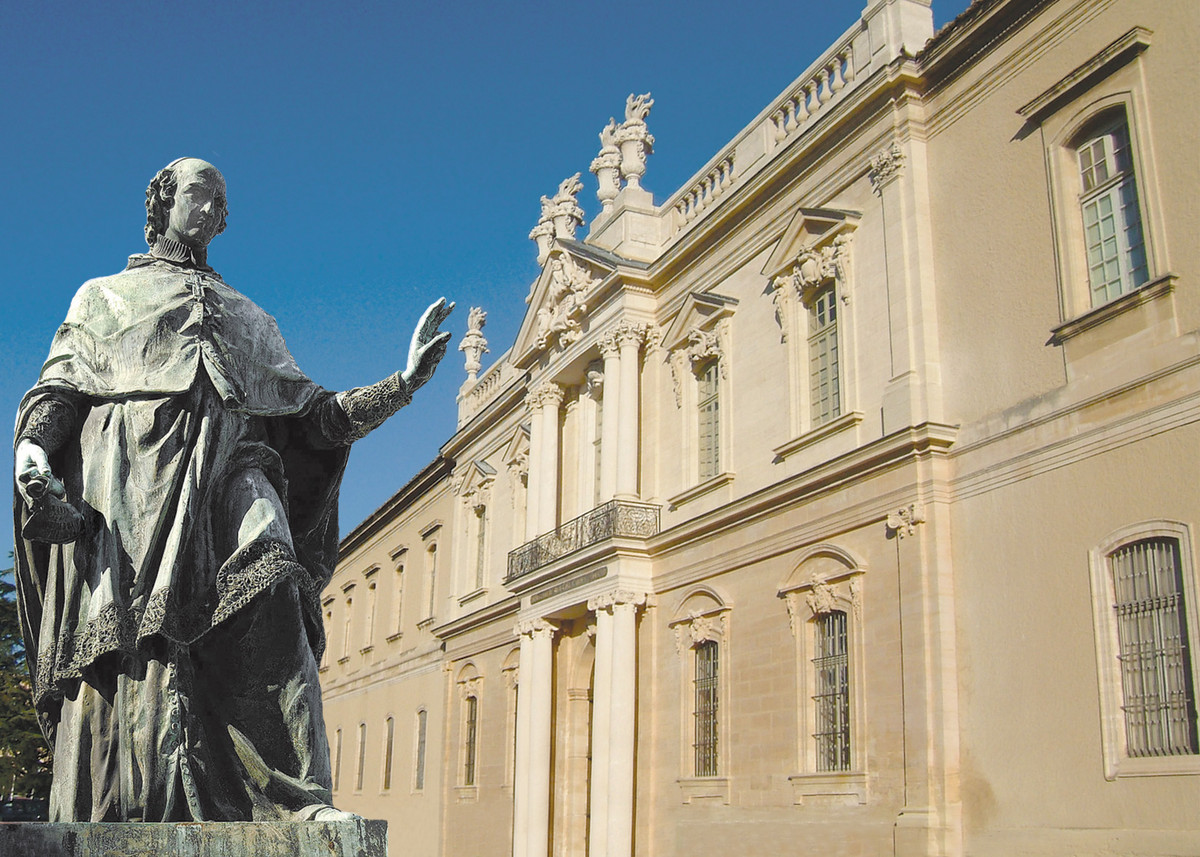


![[Translate to English:] Stèle de Taba](/fileadmin/_processed_/3/b/csm_1-stele-de-Taba_2007.0.16_Bruno-copie_8aadf552f3.jpg)
